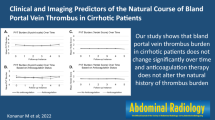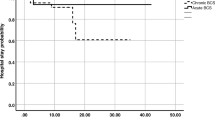Abstract
Purpose
To evaluate the frequency, CT findings, and fate of multiple infarcted regenerative nodules in patients with liver cirrhosis after variceal bleeding or septic shock.
Methods
During a recent 3-year period, 492 patients with hematemesis or melena (n = 445) and septic shock (n = 47) in liver cirrhosis visited our hospital. After applying the exclusion criteria, 136 patients with active variceal bleeding and 29 patients with septic shock were finally included in the study. We diagnosed multiple infarcted regenerative nodules based on the findings of the first follow-up (within 30 days) CT after events. We evaluated the shape, number, size, margin, location, and distribution of the infarcted regenerative nodules.
Results
Thirty-four patients were diagnosed with multiple infarcted regenerative nodules (20.6% [34/165]): 29 among 136 patients with variceal bleeding (21.3% [29/136]) and 5 among 29 patients with septic shock (17.2% [5/29]). Most of the infarcted regenerative nodules were round in shape, more than ten in number (79.4%), measured 1 cm or less (76.3%), had well-defined margins (61.8%), were present in the periphery (67.6%), and had a clustered distribution (67.6%). Almost all of the infarcted regenerative nodules disappeared on the second follow-up CT (88.9% [16/18]).
Conclusions
In cirrhotic patients, multiple infarcted regenerative nodules were not rare (they were found in about one-fifth of the patients) on the first follow-up CT after variceal bleeding or septic shock. Majority of the infarcted regenerative nodules were more than ten in number, measured 1 cm or less, were located in the periphery, and had a clustered distribution.




Similar content being viewed by others
References
Fukui N, Kitagawa K, Matsui O, et al. (1992) Focal ischemic necrosis of the liver associated with cirrhosis: radiologic findings. AJR Am J Roentgenol 159:1021–1022. doi:10.2214/ajr.159.5.1329457
Kim T, Baron RL, Nalesnik MA (2000) Infarcted regenerative nodules in cirrhosis: CT and MR imaging findings with pathologic correlation. AJR Am J Roentgenol 175:1121–1125. doi:10.2214/ajr.175.4.1751121
Yang DM, Jung DH, Kim HN, Kang JH, Kim HS (2003) Diffuse multinodular infarction of regenerative nodules after massive bleeding from esophageal varices: computed tomography findings. J Comput Assist Tomogr 27:166–168
Kang SS, Lim JH, Park CK (2004) Multiple infarcted regenerative nodules in liver cirrhosis after gastric variceal bleeding. J Hepatol 40:1040. doi:10.1016/j.jhep.2004.01.031
Kim BS, Lee CH (2008) Three cases of multiple infarcted regenerative nodules in liver cirrhosis after gastrointestinal hemorrhage. Korean J Hepatol 14:387–393. doi:10.3350/kjhep.2008.14.3.387
Kim E, Choi D, Lim HK, Lim JH (2004) Multiple infarcted regenerative nodules in liver cirrhosis after systemic hypotension due to septic shock: radiologic findings. Abdom Imaging 29:208–210. doi:10.1007/s00261-003-0121-z
Scholtze D, Reineke T, Mullhaupt B, Gubler C (2010) Multiple infarcted regenerative nodules in liver cirrhosis after decompensation of cirrhosis: a case series. J Med Case Rep 4:375. doi:10.1186/1752-1947-4-375
Kim YK, Park G, Kim CS, Han YM (2010) CT and MRI findings of cirrhosis-related benign nodules with ischaemia or infarction after variceal bleeding. Clin Radiol 65:801–808. doi:10.1016/j.crad.2010.05.004
Kleber G, Sauerbruch T, Ansari H, Paumgartner G (1991) Prediction of variceal hemorrhage in cirrhosis: a prospective follow-up study. Gastroenterology 100:1332–1337
Dellinger RP, Levy MM, Rhodes A, et al. (2013) Surviving sepsis campaign: international guidelines for management of severe sepsis and septic shock: 2012. Crit Care Med 41:580–637. doi:10.1097/CCM.0b013e31827e83af
Nakanuma Y (1995) Non-neoplastic nodular lesions in the liver. Pathol Int 45:703–714
Author information
Authors and Affiliations
Corresponding author
Rights and permissions
About this article
Cite this article
Lee, S., Choi, D., Jeong, W.K. et al. Frequency, CT findings, and fate of multiple infarcted regenerative nodules in liver cirrhosis after variceal bleeding or septic shock. Abdom Imaging 40, 835–842 (2015). https://doi.org/10.1007/s00261-014-0249-z
Published:
Issue Date:
DOI: https://doi.org/10.1007/s00261-014-0249-z




